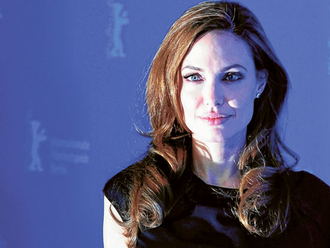
Nicky Nodjoumi’s witty, satirical paintings comment on contemporary geopolitical issues. His figurative works are inspired by media images of powerful people but he plays with the figures — distorting, misaligning and slicing them to reflect the inequality, instability and violence in our society. The US-based Iranian artist’s latest exhibition in Dubai, Fractures, explores the emotional dynamics of contemporary politics and the broken systems and structures in our fractured society.
The show is curated by New York-based curator Media Farzin for Bidoun and features large and small-scale oil on canvas paintings and ink drawings created by the artist over the last two years. Besides the distorted figures of authority, Nodjoumi has used symbols such as the harlequin, mushroom clouds, giant apes playing with missiles and roosters whose shadows look like cows to depict the hypocrisy and absurd theatre of politics. The show also includes a collection of newspaper cuttings, working sketches and collages that offer insights into the artist’s creative process.
Nodjoumi talks about his work and inspirations. Excerpts:
Who are the men in suits in your paintings?
These are corporate CEOs, politicians and other powerful, high-profile public figures. Their attire, posture and expressions signify their authority. I collect their pictures from newspapers and use them in my paintings as symbols of the actions and foibles of powerful people who happen to be mostly men.
How do you use the pictures to create your compositions?
I want to express the relations of power in my paintings so I look for a situation and a composition that touches on the relations between people, objects and spaces and their embeddedness in power. I imagine a scene, look for the right figures in my archive of newspaper clippings, cut them out and arrange them in suggestive juxtapositions and interactions to create a collage. I then make a sketch using a grid to change the scale of the figures and distort them. Though my finished painting includes the original idea, it often ends up being different from what I had in mind. The important thing for me is to look for humour though it usually becomes dark humour.
What do the distortions and fractures in the figures mean?
By magnifying the figures, I try to highlight the inequalities in our society, and the disturbed alignment of the bodies talks about displacement and dislocation. My recent work reflects what is happening in the Middle East and across the world. It is about the fracturing of coherent structures, including power structures and the relationship between the structure and its breaks. This is vividly seen in Grey Tune where I have broken and reassembled a public sculpture I saw in Prague, but also transformed the hand at the top into a fist symbolising a rebellion by the suffering masses. Sometimes the fractures in the figures also create a sense of vulnerability, such as the sliced body in Easy Enough where the social violence has come back to the body of the perpetrator. I have also created a layer of paint splatters in these paintings, which function like cuts reflecting the violence of the social situation I am depicting.
Why are the characters masked?
I use the masks because showing the faces of these well-known people would detract from the painting and the message which is not about a specific person. The masks also convey the idea of a theatre of cruelty and theatre of the absurd which is being played out on the global stage. I have also used the harlequin pattern on their suits as a reference to Picasso and to the Italian theatre tradition of commedia dell’arte suggesting that these men are powerful, but they could also be clowns.
Why are the figures so realistic and recognisable in Here is Aleppo?
This is an ink drawing that recreates a newspaper photograph showing the destruction in Aleppo during the Syrian crisis. I have removed the people who were standing amidst the rubble and added drips that look like bullets and paint splashes that express my anger. This black and white drawing is an anti-war statement. It questions why the city looks like this and the answer is in the full length, recognisable figures of four political leaders I have drawn in the background.
Do you always incorporate references to art history in your paintings?
There are many references that may or may not be visible. For example, the title of The Oaths of the Infidels comes from David’s Oath of the Horatii. But the men in my painting are not patriotic heroes fighting to save their city. My painting is based on a newspaper photograph of a heated debate in the Polish parliament where the legislators ended up physically fighting. The figures are arranged to resemble The Dance by Matisse.
Jyoti Kalsi is an arts-enthusiast based in Dubai.
Fractures will run at The Third Line, Alserkal Avenue, Al Quoz, until July 31.












